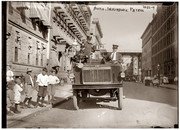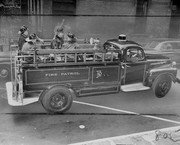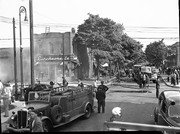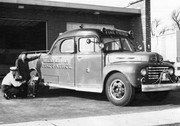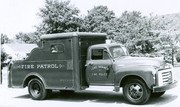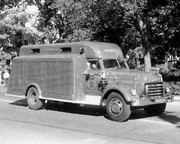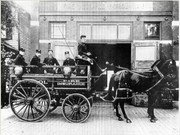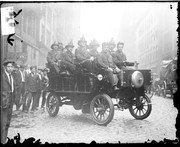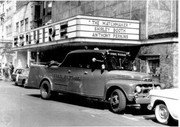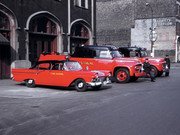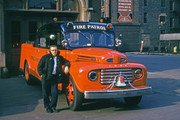You are using an out of date browser. It may not display this or other websites correctly.
You should upgrade or use an alternative browser.
You should upgrade or use an alternative browser.
Fire Patrol/Fire Police Companies/Salvage Companies
- Thread starter mack
- Start date
- Joined
- Mar 8, 2007
- Messages
- 5,392
I believe that was PEEKSKILL.mack said:
MINNEAPOLIS, MN
Minneapolis Underwriters Fire Insurance Patrol (Salvage Corp)
The Salvage Corps was disbanded in 1939.
Former Salvage Corps Station #2 528-530 University Ave. SE
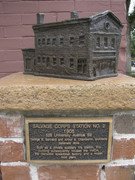
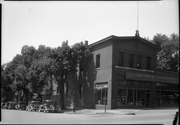
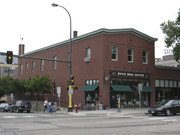
Designed by George Bertrand and Arthur Chamberlin, this Italianate building was originally a private auxiliary fire station. Such private stations, referred to as ?salvage corps,? were common in affluent neighborhoods. They were owned by insurance underwriters. When city fire trucks responded to an alarm, auxiliary station engines did, too?sometimes even leading the way. Their goal: to save as much private property as possible from fire damage, theft and destruction.
In the years to follow, this building housed the YMCA, the Garwood speedboat factory and a frozen-food plant.
Minneapolis Underwriters Fire Insurance Patrol (Salvage Corp)
The Salvage Corps was disbanded in 1939.
Former Salvage Corps Station #2 528-530 University Ave. SE



Designed by George Bertrand and Arthur Chamberlin, this Italianate building was originally a private auxiliary fire station. Such private stations, referred to as ?salvage corps,? were common in affluent neighborhoods. They were owned by insurance underwriters. When city fire trucks responded to an alarm, auxiliary station engines did, too?sometimes even leading the way. Their goal: to save as much private property as possible from fire damage, theft and destruction.
In the years to follow, this building housed the YMCA, the Garwood speedboat factory and a frozen-food plant.
BALTIMORE, MD
FIRE ENGINEERING
SALVAGE CORPS OF BALTIMORE. 07/22/1899
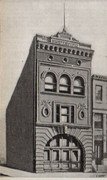
"The fire insurance salvage corps of Baltimore, Md., whose station 27 Liberty street, North, is here illustrated, in its twenty-fourth annual report states that during 1898 the corps attended 1,013 fires, and answered 900 alarms?eighty-two more than in the preceding year. Its members extinguished fifteen fires and spread 1,530 covers. Upon nine occasions all the wagons were in service at the same fire, and on nine other occasions at different fires at the same time. Of the 1,013 fires the corps attended 170 were caused by gasoline. The force consists of twelve regular men under the command of Captain J. C. McGregor, with four auxiliary and three probationary men. Part of its equipment consists of three two-horse wagons in continual service, 325) stock covers and seventy-five roof covers, and three sets of hose jumpers. During the past five years the work of the corps has increased fifty per cent, as compared with 1894, and, as the report points out,
It is only a question of a very short time, when the establishment of a second station will become an absolute necessity, if the good work of the corps is to be kept up and the interests entrusted to its care art; to be fully protected in the future as in the past.
In 1894 there were (552 alarms of fire; 1,283 covers were spread and the loss was $564,761.08. In 185)8 the number of fires (as already stated) was 1,013, with 1,538 covers spread. The increase involved was $4.851,756; the loss was $861,114.77. The present station and its equipment are in first-class condition, and t he personnel and discipline of the men are excellent; the work done by the corps, as a whole, during the year, was fully up to the standard the corps has established for itself during the past.
An early morning incendiary fire at Bloomfield. N.J , destroyed the Essex hotel, a large structure with all the stores in the lower part of the building, and for a time threatened to wipe out the business portion of the town. Loss, $15,800; insurance, nearly full. This is the fifth time that there has been a fire in this building, It was built about a year after the old Archdeacon hotel burned down, in 1883, which led to the organization of a volunteer fire department.
Chief Swenie, of the Chicago Fire Department, in his twentieth annual report?the forty-first of the paid fire department of that city*, states that a three-story brick building will be erected on a lot at 2 Washington street, which has been leased for a term of ten years. In this home will be quartered engine company No. 32, and hook and ladder company No. 5). A two-story brick building will also be erected at 1476 West Huron street, and a two-story frame building at 17 West Cuyler avenue?each of which will be occupied by an engine company. A lot for a fire house has also been purchased on Sixtieth street and St. Louis avenue, in which a new fire company will be accommodated, and a two-story frame building leased at 5623 South Ilalsted street, for the housing of engine company No. 84. The new steam fireboat Illinois, appropriated for out of the proceeds of the tax on foreign insurance companies, has been completed for the use of engine company No. 37. She will replace the Chicago at South Chicago?the latter fireboat being held in reserve. Chief Swenie asks appropriations for six additional houses (frame); for seven new engine companies, one hook and ladder company, one chemical engine company, and four reserve engine companies; for two additional trucks and three additional engines to replace those worn out in the service; for fifteen additional men for duty at the principal theatres ; and for water mains leading from the Chicago river, to be used by the fireboats for conveying water by direct pressure in case of fire. There are available for fire purposes 1,801 miles of water mains. There were 519 fire hydrants set last year, making the total in use on December 31, 1898, 18,311, as follows: Double two and one-half-inch, with four-inch, 2,257; double four-inch. 581; double two and one-half-inch, 11,233; single two and one-half-inch, 4,240. Two fire cisterns were built?the number available for fire purposes being 102. The aggregate value of the property in use by the department is $1,979,385, of which $943,510 is in apparatus, as follows: Fireboats, five; water towers, two; steam fire engines, ninety-two; hand engines, four; chemical engines, twenty-five; hose wagons, fifty two; hose carriages, twenty-six; hook and ladder trucks?all kinds,27;chemicalextinguishers.nine; portable pumps, 101; hose, 195,809feet; horses, 475. The uniformed force, exclusive of the fire marshal?s staff, comprises eighty-four engine companies, including one double company and four fireboat crews, two of which also operate the water towers, twenty seven hook and ladder companies, and one hose company. The uniformed force consists of 1,078 members; the non-uniformed, of eight; the city telegraph staff, of forty?making a grand total of 1,126. The city is divided into sixteen battalion districts. During the year there occurred forty-six slight, twenty severe, three serious, and six fatal accidents to members of the department while on duty. Four received fatal injuries (two being instantly killed) at an otherwise unimportant fire where the walls of a two-story livery stable collapsed. The total number of fire alarms in 1898 was 6,581; of actual fires, 5,048?being 326 less alarms and 278 less fires than in 1897. The loss however, was $288,745greater?the average loss per fire being $525, or $100 more than in 1897.
Seven hundred and thirty-nine fires were due to the use of gasoline and kerosene, resulting in the loss of twenty-one lives and the more or less serious injury to forty-two other persons. Electric wires and lights were responsible for 134 fires; defective flues, for 205. The aggregate loss for the year amounted to $2,651,735, as follows: Loss on buildings. $1,129,030; on contents, $1,522,705. The total value of the property at risk was $91,022,210. The total insurance was $56,550,470; insurance over loss, $54,004,005; loss over insurance, $105,270. The percentage of loss on property involved was 2.88.
Of the total number of fires, 1,063 were of small importance, being either chimney fires, burning of rubbish, etc., or fires that were extinguished before the arrival of the department. Eight hundred and eighteen required the services of steam fire engines; 403 were extinguished by the use of chemicals; and 2,373, by the use of chemicals in conjunction with other apparatus. Of the 5,048 fires 702 were extinguished before the arrival of the fire department; 139 by the department smothering, cutting out with axes, etc.; seventy-nine, with pails of water; 101, with fire hydrant stream; twelve, with hydrant stream and chemical; 1,768, with portable pumps and chemical extinguishers; thirty-six, with chemical extinguishers; 359, with one chemical engine; eight, with two or more chemical engines; 665, with one steam engine; 251, with one steam engine and two or more chemical engines; 225, with two or more steam engines; 294, with two or more steam engines and chemical engines; chimney fires, prairie fires, burning rubbish, etc., 361. The fire inspector reports that during 1898 230 fires were investigated; thirteen persons were arrested; five were indicted; four were convicted, and 108 persons were examined under oath in reference to the origin of the fires. In many cases the examination disclosed the true cause of the fire." _
The Baltimore Fire Insurance Salvage Corps operated from 1873-1958.
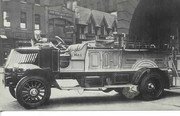

FIRE ENGINEERING
SALVAGE CORPS OF BALTIMORE. 07/22/1899

"The fire insurance salvage corps of Baltimore, Md., whose station 27 Liberty street, North, is here illustrated, in its twenty-fourth annual report states that during 1898 the corps attended 1,013 fires, and answered 900 alarms?eighty-two more than in the preceding year. Its members extinguished fifteen fires and spread 1,530 covers. Upon nine occasions all the wagons were in service at the same fire, and on nine other occasions at different fires at the same time. Of the 1,013 fires the corps attended 170 were caused by gasoline. The force consists of twelve regular men under the command of Captain J. C. McGregor, with four auxiliary and three probationary men. Part of its equipment consists of three two-horse wagons in continual service, 325) stock covers and seventy-five roof covers, and three sets of hose jumpers. During the past five years the work of the corps has increased fifty per cent, as compared with 1894, and, as the report points out,
It is only a question of a very short time, when the establishment of a second station will become an absolute necessity, if the good work of the corps is to be kept up and the interests entrusted to its care art; to be fully protected in the future as in the past.
In 1894 there were (552 alarms of fire; 1,283 covers were spread and the loss was $564,761.08. In 185)8 the number of fires (as already stated) was 1,013, with 1,538 covers spread. The increase involved was $4.851,756; the loss was $861,114.77. The present station and its equipment are in first-class condition, and t he personnel and discipline of the men are excellent; the work done by the corps, as a whole, during the year, was fully up to the standard the corps has established for itself during the past.
An early morning incendiary fire at Bloomfield. N.J , destroyed the Essex hotel, a large structure with all the stores in the lower part of the building, and for a time threatened to wipe out the business portion of the town. Loss, $15,800; insurance, nearly full. This is the fifth time that there has been a fire in this building, It was built about a year after the old Archdeacon hotel burned down, in 1883, which led to the organization of a volunteer fire department.
Chief Swenie, of the Chicago Fire Department, in his twentieth annual report?the forty-first of the paid fire department of that city*, states that a three-story brick building will be erected on a lot at 2 Washington street, which has been leased for a term of ten years. In this home will be quartered engine company No. 32, and hook and ladder company No. 5). A two-story brick building will also be erected at 1476 West Huron street, and a two-story frame building at 17 West Cuyler avenue?each of which will be occupied by an engine company. A lot for a fire house has also been purchased on Sixtieth street and St. Louis avenue, in which a new fire company will be accommodated, and a two-story frame building leased at 5623 South Ilalsted street, for the housing of engine company No. 84. The new steam fireboat Illinois, appropriated for out of the proceeds of the tax on foreign insurance companies, has been completed for the use of engine company No. 37. She will replace the Chicago at South Chicago?the latter fireboat being held in reserve. Chief Swenie asks appropriations for six additional houses (frame); for seven new engine companies, one hook and ladder company, one chemical engine company, and four reserve engine companies; for two additional trucks and three additional engines to replace those worn out in the service; for fifteen additional men for duty at the principal theatres ; and for water mains leading from the Chicago river, to be used by the fireboats for conveying water by direct pressure in case of fire. There are available for fire purposes 1,801 miles of water mains. There were 519 fire hydrants set last year, making the total in use on December 31, 1898, 18,311, as follows: Double two and one-half-inch, with four-inch, 2,257; double four-inch. 581; double two and one-half-inch, 11,233; single two and one-half-inch, 4,240. Two fire cisterns were built?the number available for fire purposes being 102. The aggregate value of the property in use by the department is $1,979,385, of which $943,510 is in apparatus, as follows: Fireboats, five; water towers, two; steam fire engines, ninety-two; hand engines, four; chemical engines, twenty-five; hose wagons, fifty two; hose carriages, twenty-six; hook and ladder trucks?all kinds,27;chemicalextinguishers.nine; portable pumps, 101; hose, 195,809feet; horses, 475. The uniformed force, exclusive of the fire marshal?s staff, comprises eighty-four engine companies, including one double company and four fireboat crews, two of which also operate the water towers, twenty seven hook and ladder companies, and one hose company. The uniformed force consists of 1,078 members; the non-uniformed, of eight; the city telegraph staff, of forty?making a grand total of 1,126. The city is divided into sixteen battalion districts. During the year there occurred forty-six slight, twenty severe, three serious, and six fatal accidents to members of the department while on duty. Four received fatal injuries (two being instantly killed) at an otherwise unimportant fire where the walls of a two-story livery stable collapsed. The total number of fire alarms in 1898 was 6,581; of actual fires, 5,048?being 326 less alarms and 278 less fires than in 1897. The loss however, was $288,745greater?the average loss per fire being $525, or $100 more than in 1897.
Seven hundred and thirty-nine fires were due to the use of gasoline and kerosene, resulting in the loss of twenty-one lives and the more or less serious injury to forty-two other persons. Electric wires and lights were responsible for 134 fires; defective flues, for 205. The aggregate loss for the year amounted to $2,651,735, as follows: Loss on buildings. $1,129,030; on contents, $1,522,705. The total value of the property at risk was $91,022,210. The total insurance was $56,550,470; insurance over loss, $54,004,005; loss over insurance, $105,270. The percentage of loss on property involved was 2.88.
Of the total number of fires, 1,063 were of small importance, being either chimney fires, burning of rubbish, etc., or fires that were extinguished before the arrival of the department. Eight hundred and eighteen required the services of steam fire engines; 403 were extinguished by the use of chemicals; and 2,373, by the use of chemicals in conjunction with other apparatus. Of the 5,048 fires 702 were extinguished before the arrival of the fire department; 139 by the department smothering, cutting out with axes, etc.; seventy-nine, with pails of water; 101, with fire hydrant stream; twelve, with hydrant stream and chemical; 1,768, with portable pumps and chemical extinguishers; thirty-six, with chemical extinguishers; 359, with one chemical engine; eight, with two or more chemical engines; 665, with one steam engine; 251, with one steam engine and two or more chemical engines; 225, with two or more steam engines; 294, with two or more steam engines and chemical engines; chimney fires, prairie fires, burning rubbish, etc., 361. The fire inspector reports that during 1898 230 fires were investigated; thirteen persons were arrested; five were indicted; four were convicted, and 108 persons were examined under oath in reference to the origin of the fires. In many cases the examination disclosed the true cause of the fire." _
The Baltimore Fire Insurance Salvage Corps operated from 1873-1958.



